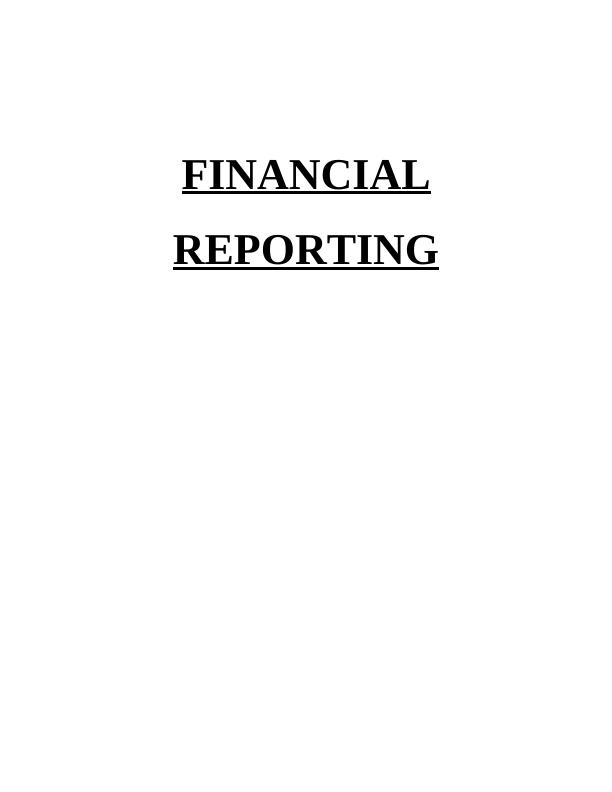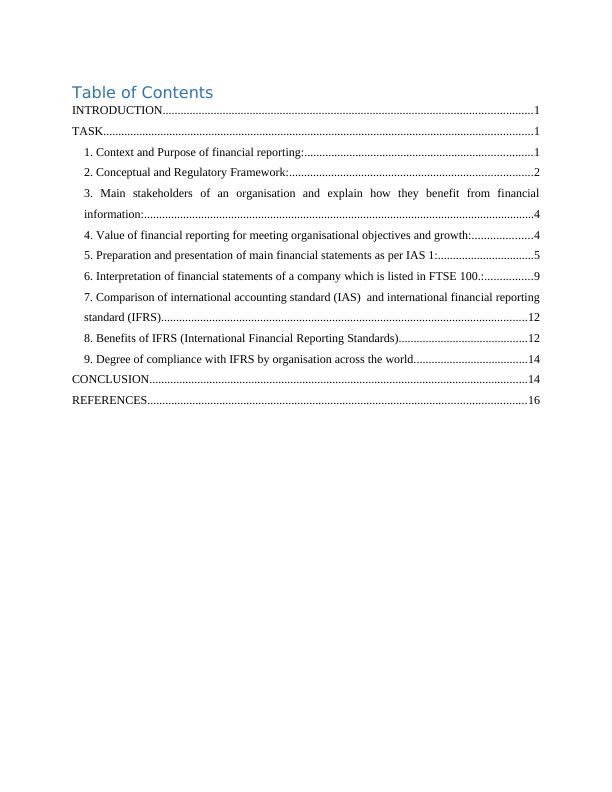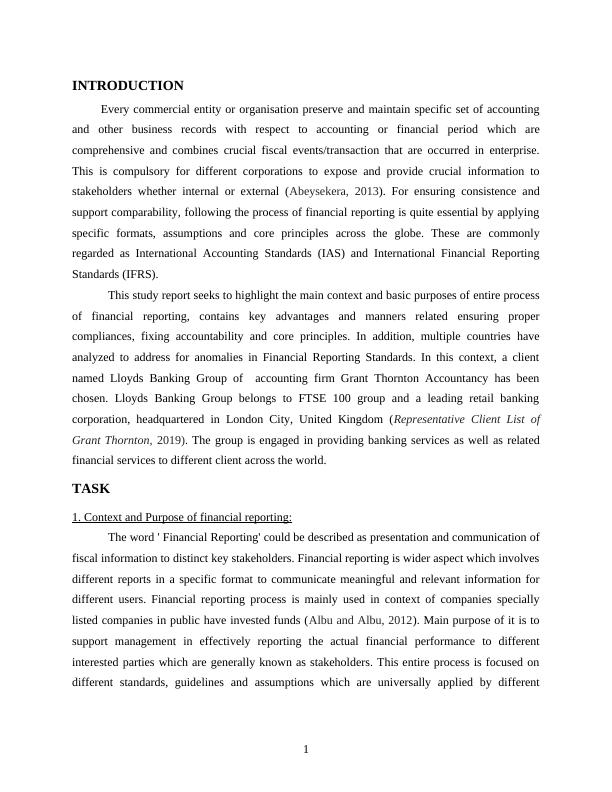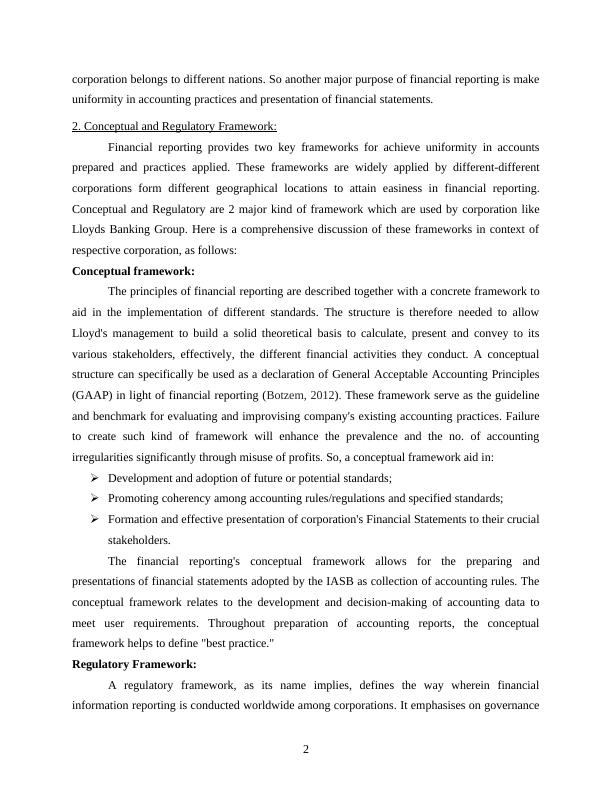Financial Reporting: Context, Purpose, and Stakeholders
19 Pages4994 Words51 Views
Added on 2023-01-13
About This Document
This study report highlights the context and purpose of financial reporting, the conceptual and regulatory framework, the main stakeholders of an organization, and how they benefit from financial information. It also discusses the value of financial reporting for meeting organizational objectives and growth, and the preparation and presentation of main financial statements as per IAS 1.
Financial Reporting: Context, Purpose, and Stakeholders
Added on 2023-01-13
ShareRelated Documents
FINANCIAL
REPORTING
REPORTING

Table of Contents
INTRODUCTION...........................................................................................................................1
TASK...............................................................................................................................................1
1. Context and Purpose of financial reporting:............................................................................1
2. Conceptual and Regulatory Framework:.................................................................................2
3. Main stakeholders of an organisation and explain how they benefit from financial
information:..................................................................................................................................4
4. Value of financial reporting for meeting organisational objectives and growth:....................4
5. Preparation and presentation of main financial statements as per IAS 1:................................5
6. Interpretation of financial statements of a company which is listed in FTSE 100.:................9
7. Comparison of international accounting standard (IAS) and international financial reporting
standard (IFRS)..........................................................................................................................12
8. Benefits of IFRS (International Financial Reporting Standards)...........................................12
9. Degree of compliance with IFRS by organisation across the world......................................14
CONCLUSION..............................................................................................................................14
REFERENCES..............................................................................................................................16
INTRODUCTION...........................................................................................................................1
TASK...............................................................................................................................................1
1. Context and Purpose of financial reporting:............................................................................1
2. Conceptual and Regulatory Framework:.................................................................................2
3. Main stakeholders of an organisation and explain how they benefit from financial
information:..................................................................................................................................4
4. Value of financial reporting for meeting organisational objectives and growth:....................4
5. Preparation and presentation of main financial statements as per IAS 1:................................5
6. Interpretation of financial statements of a company which is listed in FTSE 100.:................9
7. Comparison of international accounting standard (IAS) and international financial reporting
standard (IFRS)..........................................................................................................................12
8. Benefits of IFRS (International Financial Reporting Standards)...........................................12
9. Degree of compliance with IFRS by organisation across the world......................................14
CONCLUSION..............................................................................................................................14
REFERENCES..............................................................................................................................16

INTRODUCTION
Every commercial entity or organisation preserve and maintain specific set of accounting
and other business records with respect to accounting or financial period which are
comprehensive and combines crucial fiscal events/transaction that are occurred in enterprise.
This is compulsory for different corporations to expose and provide crucial information to
stakeholders whether internal or external (Abeysekera, 2013). For ensuring consistence and
support comparability, following the process of financial reporting is quite essential by applying
specific formats, assumptions and core principles across the globe. These are commonly
regarded as International Accounting Standards (IAS) and International Financial Reporting
Standards (IFRS).
This study report seeks to highlight the main context and basic purposes of entire process
of financial reporting, contains key advantages and manners related ensuring proper
compliances, fixing accountability and core principles. In addition, multiple countries have
analyzed to address for anomalies in Financial Reporting Standards. In this context, a client
named Lloyds Banking Group of accounting firm Grant Thornton Accountancy has been
chosen. Lloyds Banking Group belongs to FTSE 100 group and a leading retail banking
corporation, headquartered in London City, United Kingdom (Representative Client List of
Grant Thornton, 2019). The group is engaged in providing banking services as well as related
financial services to different client across the world.
TASK
1. Context and Purpose of financial reporting:
The word ' Financial Reporting' could be described as presentation and communication of
fiscal information to distinct key stakeholders. Financial reporting is wider aspect which involves
different reports in a specific format to communicate meaningful and relevant information for
different users. Financial reporting process is mainly used in context of companies specially
listed companies in public have invested funds (Albu and Albu, 2012). Main purpose of it is to
support management in effectively reporting the actual financial performance to different
interested parties which are generally known as stakeholders. This entire process is focused on
different standards, guidelines and assumptions which are universally applied by different
1
Every commercial entity or organisation preserve and maintain specific set of accounting
and other business records with respect to accounting or financial period which are
comprehensive and combines crucial fiscal events/transaction that are occurred in enterprise.
This is compulsory for different corporations to expose and provide crucial information to
stakeholders whether internal or external (Abeysekera, 2013). For ensuring consistence and
support comparability, following the process of financial reporting is quite essential by applying
specific formats, assumptions and core principles across the globe. These are commonly
regarded as International Accounting Standards (IAS) and International Financial Reporting
Standards (IFRS).
This study report seeks to highlight the main context and basic purposes of entire process
of financial reporting, contains key advantages and manners related ensuring proper
compliances, fixing accountability and core principles. In addition, multiple countries have
analyzed to address for anomalies in Financial Reporting Standards. In this context, a client
named Lloyds Banking Group of accounting firm Grant Thornton Accountancy has been
chosen. Lloyds Banking Group belongs to FTSE 100 group and a leading retail banking
corporation, headquartered in London City, United Kingdom (Representative Client List of
Grant Thornton, 2019). The group is engaged in providing banking services as well as related
financial services to different client across the world.
TASK
1. Context and Purpose of financial reporting:
The word ' Financial Reporting' could be described as presentation and communication of
fiscal information to distinct key stakeholders. Financial reporting is wider aspect which involves
different reports in a specific format to communicate meaningful and relevant information for
different users. Financial reporting process is mainly used in context of companies specially
listed companies in public have invested funds (Albu and Albu, 2012). Main purpose of it is to
support management in effectively reporting the actual financial performance to different
interested parties which are generally known as stakeholders. This entire process is focused on
different standards, guidelines and assumptions which are universally applied by different
1

corporation belongs to different nations. So another major purpose of financial reporting is make
uniformity in accounting practices and presentation of financial statements.
2. Conceptual and Regulatory Framework:
Financial reporting provides two key frameworks for achieve uniformity in accounts
prepared and practices applied. These frameworks are widely applied by different-different
corporations form different geographical locations to attain easiness in financial reporting.
Conceptual and Regulatory are 2 major kind of framework which are used by corporation like
Lloyds Banking Group. Here is a comprehensive discussion of these frameworks in context of
respective corporation, as follows:
Conceptual framework:
The principles of financial reporting are described together with a concrete framework to
aid in the implementation of different standards. The structure is therefore needed to allow
Lloyd's management to build a solid theoretical basis to calculate, present and convey to its
various stakeholders, effectively, the different financial activities they conduct. A conceptual
structure can specifically be used as a declaration of General Acceptable Accounting Principles
(GAAP) in light of financial reporting (Botzem, 2012). These framework serve as the guideline
and benchmark for evaluating and improvising company's existing accounting practices. Failure
to create such kind of framework will enhance the prevalence and the no. of accounting
irregularities significantly through misuse of profits. So, a conceptual framework aid in:
Development and adoption of future or potential standards;
Promoting coherency among accounting rules/regulations and specified standards;
Formation and effective presentation of corporation's Financial Statements to their crucial
stakeholders.
The financial reporting's conceptual framework allows for the preparing and
presentations of financial statements adopted by the IASB as collection of accounting rules. The
conceptual framework relates to the development and decision-making of accounting data to
meet user requirements. Throughout preparation of accounting reports, the conceptual
framework helps to define "best practice."
Regulatory Framework:
A regulatory framework, as its name implies, defines the way wherein financial
information reporting is conducted worldwide among corporations. It emphasises on governance
2
uniformity in accounting practices and presentation of financial statements.
2. Conceptual and Regulatory Framework:
Financial reporting provides two key frameworks for achieve uniformity in accounts
prepared and practices applied. These frameworks are widely applied by different-different
corporations form different geographical locations to attain easiness in financial reporting.
Conceptual and Regulatory are 2 major kind of framework which are used by corporation like
Lloyds Banking Group. Here is a comprehensive discussion of these frameworks in context of
respective corporation, as follows:
Conceptual framework:
The principles of financial reporting are described together with a concrete framework to
aid in the implementation of different standards. The structure is therefore needed to allow
Lloyd's management to build a solid theoretical basis to calculate, present and convey to its
various stakeholders, effectively, the different financial activities they conduct. A conceptual
structure can specifically be used as a declaration of General Acceptable Accounting Principles
(GAAP) in light of financial reporting (Botzem, 2012). These framework serve as the guideline
and benchmark for evaluating and improvising company's existing accounting practices. Failure
to create such kind of framework will enhance the prevalence and the no. of accounting
irregularities significantly through misuse of profits. So, a conceptual framework aid in:
Development and adoption of future or potential standards;
Promoting coherency among accounting rules/regulations and specified standards;
Formation and effective presentation of corporation's Financial Statements to their crucial
stakeholders.
The financial reporting's conceptual framework allows for the preparing and
presentations of financial statements adopted by the IASB as collection of accounting rules. The
conceptual framework relates to the development and decision-making of accounting data to
meet user requirements. Throughout preparation of accounting reports, the conceptual
framework helps to define "best practice."
Regulatory Framework:
A regulatory framework, as its name implies, defines the way wherein financial
information reporting is conducted worldwide among corporations. It emphasises on governance
2

End of preview
Want to access all the pages? Upload your documents or become a member.
Related Documents
International Financial Reporting Solved Assignmentlg...
|16
|4741
|27
Financial Reporting Assignment Solved (Doc)lg...
|16
|4262
|68
Financial Reporting: Assignmentlg...
|18
|4797
|439
International Financial Reportinglg...
|15
|3926
|324
Financial Reporting Assignment : Lloyds Banking Grouplg...
|18
|3963
|64
Difference Between IAS and IFRS: PDFlg...
|5
|492
|30
